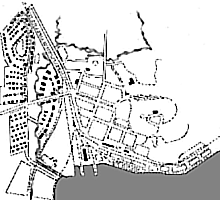
The territory of district was occupied by Karelian tribes as far back as the Ist thousand B.C. A long time main occupations of region's inhabitants were gathering, hunting, fishing and further farming. A population of the lakeside constructed light but stable boats by those sailed successfully for Ladoga and rivers opened up new lands.
Since IX ( from 874) "Korela" tribe had mentioned in Scandinavian chronicles. Karelians (Korela) didn't establish an own State.
When Great Novgorod had became a feudal republic in 1136 it combined under its supervision all territories in the North with lived there inhabitants. In 1227 for Novgorod was adopted Christianity.
Since the latter half of the XIII century until beginning of the XIX century was repeatedly redrawn Karelian lands as a result of the wars with Sweden.
In the birch document of 1396 discovered from the excavations in Novgorod were mentioned Kyuriyesky pogost (churchyard), Hiitola and Kurkijoki settlements. Kyuriyesky - Kiryazhsky - Kronborgsky - Kurkiyoksky -Lahdenpohsky - that sort of historical names of the territory where people of Lahdenpohja live at present.
It had been passed ever about hundred years and in 1478 Bogoroditsky Kiryazhsky pogost with Kurkijoki centre among pogosts of Korelsky uyezd became part of Moskovskoye State.
In 1617 by Long-established Peace Sweden got Korelsky uyezd with Korela town (Keksgolm-Käkisalmi-Priozersk) including Kiryazhsky uyezd.
When in 1721 Nischtadt Peace had put an end to The Northern War after then Kurkijoki had new masters. Large number of tsar's dignitaries including daughter of tsar had got lands in Kurkijoki, Lumivaara and Jakkimaa and held them for many long years.
Next landmark of this region history was 1809. In that year Russian tsar became Grand Duke of Finland and the territory of pogost was a part of Grand Duchy of Finland. There wasn't serfdom on territory of the uyezd. For hundred years all of granted estates had been got out of pawn and national estates had been opened on their basis.
In 1851 the Protestant church by project of Finnish remarkable architect K.Enkel was consecrated in Jakkimaa. Now this church that was ruined in the fifties is being restored.
In 1893 the railway ran through the district connected it to Helsinki, Vyborg and Sortavala.
The declaration of independence of Finland had stimulated further development of economics, agriculture production, small enterprises, was build a veneer plant.
In 1924 Sieklahti settlement and Lahdenpohja village separated from Jakkimaa and they are formed Lahdenpohja settlement.

After Winter War (1939-1940) the territory of district passed to USSR and Kurkijoksky district with centre of Kurkijoki settlement was formed in 1940. The district was becoming peopled with migrants from other regions of USSR.
In June of 1941 the fierce battles deployed in districts of Ladoga and to beginning of September Soviet troops abandoned this district and then returned there in September of 1944 according terms of armistice.
In January of 1945 the centre of district was moved from Kurkijoki settlement to just formed Lahdenpohja town. In 1958 district was abolished and placed to Sortavalsky district, but from December of 1970 it was restored as Lahdenpohsky district.